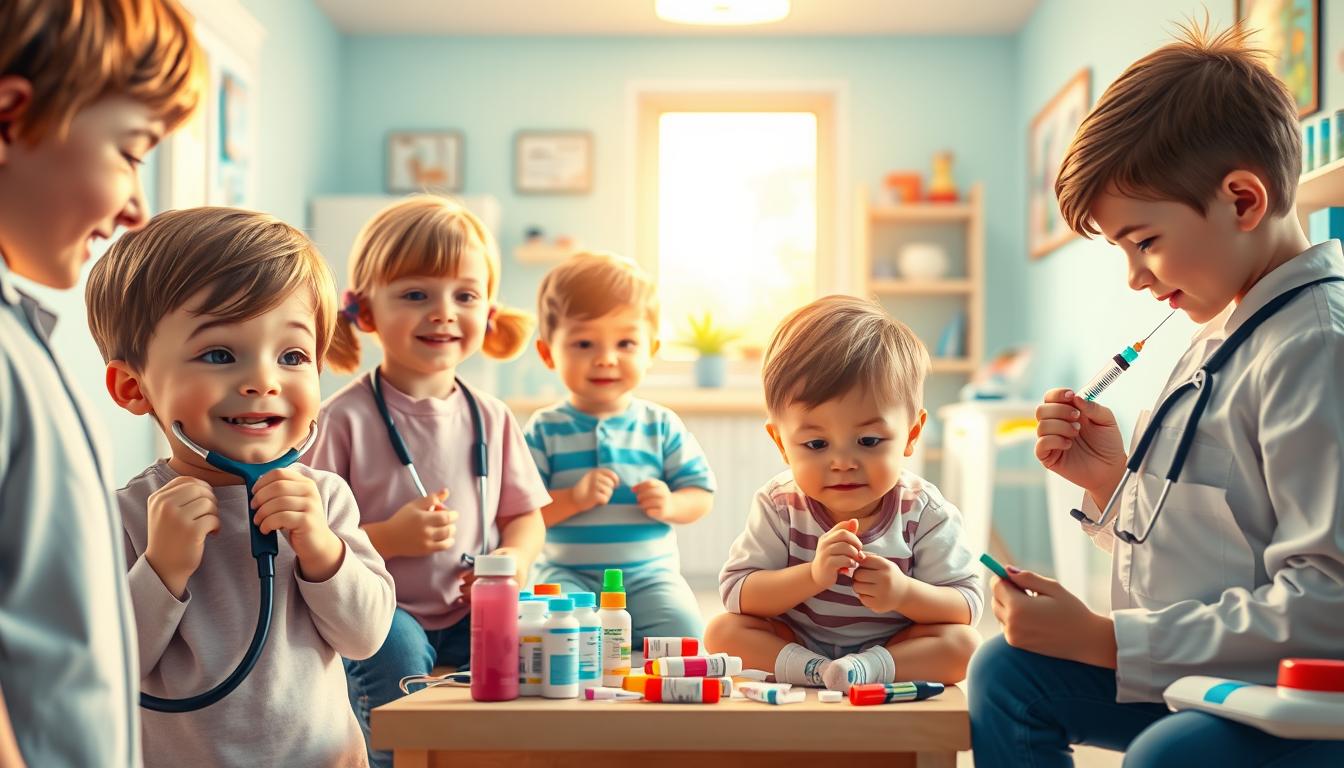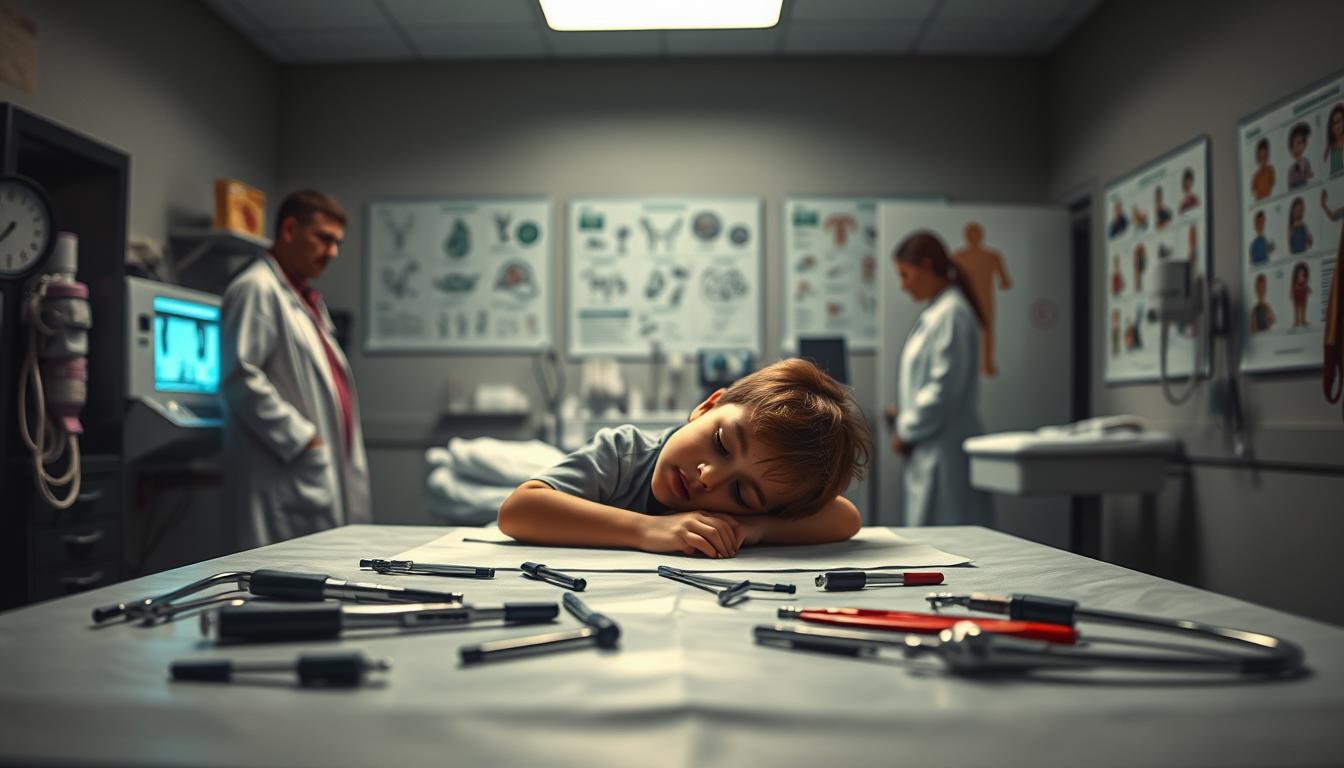Health Concerns for Children Under 18
As a parent or guardian, you worry a lot about your children’s health. Pediatric health concerns are very important. Knowing about them is the first step to keep your kids safe.

Children under 18 face many children’s health ailments. These range from simple colds to serious problems. Learning about these health issues helps you protect your child’s health.
Key Takeaways
- Common health concerns affecting children under 18
- Importance of early detection and prevention
- Role of parents in maintaining their child’s health
- Overview of pediatric health concerns
- Tips for keeping your child healthy
Current State of Children’s Health in America
It’s important to know how children’s health is doing. As a parent or guardian, you might worry about what affects your child’s health.
Key Statistics on Pediatric Health in the US
Recent data shows us how children’s health is across America. Some important facts include:
- Prevalence of chronic conditions: The CDC says more children have chronic health issues now.
- Demographic disparities: Health results differ a lot between different groups, showing we need special help.
Recent CDC Reports on Children’s Health
The CDC has found that some health problems in kids are getting worse. These include mental health issues and more kids being overweight.
Demographic Disparities in Health Outcomes
Health results vary a lot based on race and how much money families have. Kids from poorer families often face bigger health problems.
Emerging Trends in Pediatric Healthcare
Pediatric healthcare is changing, with new trends because of health changes.
Post-Pandemic Health Patterns
The COVID-19 pandemic has changed kids’ health a lot. Kids are spending more time on screens and some health issues are being missed. It’s key to understand these changes to help kids better.
We need to tackle these issues to make sure kids under 18 in America are healthier.
Common Health Issue in Child Under18: An Overview
It’s important for parents and caregivers to know about health issues in kids under 18. Kids in this age group face many health challenges. These can be either short-term or long-term.
Most Prevalent Pediatric Conditions in 2023
In 2023, kids often get respiratory infections, allergies, and skin problems. These can be either short-term or long-term.
Acute vs. Chronic Conditions
Short-term illnesses like the flu or common colds usually get better with treatment. Long-term conditions, like asthma or diabetes, need constant care.
Age-Specific Health Concerns
Health issues change a lot as kids grow.
Infancy (0-2 years)
Babies are at risk for infections and issues like jaundice and feeding problems.
Early Childhood (3-5 years)
Young kids often get sick and are at risk for accidents.
School Age (6-12 years)
School kids deal with obesity, learning disabilities, and mental health problems.
Adolescence (13-17 years)
Teenagers face mental health issues, substance abuse, and sexual health problems.
|
Age Group |
Common Health Issues |
|---|---|
|
Infancy (0-2 years) |
Jaundice, feeding difficulties, infections |
|
Early Childhood (3-5 years) |
Common infections, accidents |
|
School Age (6-12 years) |
Obesity, learning disabilities, mental health issues |
|
Adolescence (13-17 years) |
Mental health concerns, substance abuse, sexual health issues |
Respiratory Conditions Affecting American Youth
As a parent, you might know about more kids getting sick with breathing problems in the U.S. These health issues are big worries for kids under 18. They can really affect their life and health. The main problems are asthma, RSV infections, and COVID-19’s effects on kids’ lungs.
Asthma: Rising Rates and New Treatments
Asthma is a big problem for kids. Studies show more kids are getting asthma. New treatments are being made to help manage it better.
Environmental Triggers and Management
Things like air pollution and allergens can make asthma worse. To control asthma, kids need to stay away from these things. They also need the right medicine. Knowing and avoiding these triggers is key for kids with asthma.
Respiratory Infections: RSV and Beyond
RSV is a big cause of sickness in young kids. New RSV vaccine research gives hope for fewer severe RSV cases.
Recent RSV Vaccine Developments
There are many RSV vaccine tests going on. Early results look good, showing they might cut down on RSV hospital visits for kids.
COVID-19’s Ongoing Impact on Children’s Lungs
The COVID-19 pandemic has hurt kids’ breathing health. There’s worry about lasting lung damage.
Long COVID in Pediatric Populations
Long COVID means having COVID-19 symptoms for a long time. Kids can have breathing problems and other symptoms. Doctors are still learning about long COVID in kids.
Knowing about these breathing problems helps parents and doctors help kids stay healthy.
Childhood Obesity and Nutritional Concerns
As a parent, you know about childhood obesity and its health risks. Obesity in kids is a big problem in America. It affects their health now and in the future.
Latest Obesity Statistics Among American Children
About 1 in 5 kids in the U.S. have childhood obesity. This is a big health issue. It also affects their families and where they live.
Regional and Socioeconomic Factors
Socioeconomic status and geographic location matter a lot. Kids in poor areas or with no healthy food or places to play are more likely to be obese.
Nutritional Deficiencies in Modern Diets
Many kids also lack important nutrients. They might not get enough Vitamin D or iron. This can hurt their health a lot.
Vitamin D and Iron Deficiency Trends
Kids with low Vitamin D might have weak bones. Iron deficiency can slow their growth and hurt their brain.

New Initiatives for Promoting Healthy Eating
New plans are starting to help kids eat better. These include teaching them about food and changing school meals.
School Lunch Program Updates
The National School Lunch Program is now offering healthier meals. They focus on whole grains, fruits, and veggies. They also cut down on bad fats and salt.
By learning about these problems and supporting healthy habits, you can help keep your child safe and healthy.
Mental Health Crisis Among American Youth
The mental health crisis among American youth is getting worse. As a parent, you might know about the teen health issues and pediatric health concerns affecting kids under 18.
Anxiety and Depression: Record-High Numbers
Anxiety and depression are on the rise among American youth. The numbers are alarming, showing more young people dealing with these issues.
Warning Signs Parents Should Know
It’s key for parents to spot the signs of anxiety and depression in their kids. Look out for:
- Changes in mood or behavior
- Withdrawal from social activities
- Difficulty sleeping or concentrating
Social Media’s Evolving Impact on Mental Wellbeing
Social media is a big part of the mental health crisis among youth. Sites like TikTok and Instagram can deeply affect a young person’s self-image.
TikTok and Instagram Effects on Self-Image
The constant exposure to perfect images can lead to unrealistic comparisons. It’s vital to watch your child’s social media use and talk about its effects on their mental health.
New Resources for Youth Mental Health Support
There are new resources for supporting youth mental health. These include:
- The 988 Crisis Line
- Digital therapy options
These resources offer crucial support for young people facing mental health challenges.
Developmental and Learning Disorders
It’s important for parents and caregivers to understand developmental and learning disorders in kids under 18. These issues can affect a child’s school work, social skills, and happiness.
ADHD: New Diagnostic Criteria and Treatment Approaches
Attention Deficit Hyperactivity Disorder (ADHD) is common in kids. New rules for diagnosing ADHD focus on detailed checks. These include watching the child’s behavior and talking to a psychologist.
Non-Medication Management Strategies
While medicine helps with ADHD, other methods are key too. These include therapy, staying active, eating well, and getting school help that fits the child.
“Early intervention and a comprehensive treatment plan can significantly improve the quality of life for children with ADHD.”
– Dr. Jane Smith, Pediatrician
Autism Spectrum Disorders: Earlier Detection
Autism Spectrum Disorder (ASD) makes socializing, speaking, and acting repetitive. Thanks to better tests and awareness, we catch it sooner.
Breakthrough Research in ASD
New studies are uncovering what causes ASD. This knowledge helps create better treatments and therapies.
Learning Disabilities and Post-Pandemic Educational Support
The pandemic showed we need strong support for kids with learning disabilities. Plans like IEPs and 504 Plans are key for custom education.
IEP and 504 Plan Updates
IEPs and 504 Plans now offer more flexible help for kids with learning issues. They use technology and make learning plans that fit each child.
|
Condition |
Key Characteristics |
Support Strategies |
|---|---|---|
|
ADHD |
Inattention, Hyperactivity, Impulsivity |
Behavioral Therapy, Lifestyle Changes, Educational Support |
|
Autism Spectrum Disorder |
Social Challenges, Repetitive Behaviors |
Early Intervention, Targeted Therapies, Educational Support |
|
Learning Disabilities |
Difficulties with Reading, Writing, Math |
IEPs, 504 Plans, Personalized Learning |
Infectious Diseases and Vaccination Updates
It’s important to know about infectious diseases and vaccination updates for kids under 18. New research and health guidelines come out often. Keeping up with these helps keep your child healthy.
2023-2024 Vaccination Schedule Changes
The 2023-2024 vaccination schedule for kids has big changes. New recommendations from health experts aim to better protect against diseases.
New Vaccines Available for Children
New vaccines are now available to fight off new health threats. For example, recent advancements in vaccine tech offer better protection against flu and viral infections.
Resurgence of Measles and Other Preventable Diseases
Measles and other preventable diseases are coming back in some places.
“Vaccination is one of the most effective ways to prevent the spread of infectious diseases,”
This shows why sticking to vaccination schedules is so important.
Vaccination Rate Trends by State
Vaccination rates differ a lot between states. This shows gaps in healthcare and education. Knowing these trends helps health officials focus on where they need to improve.
Emerging Infectious Threats to Children
New infectious threats to kids keep popping up. It’s key for parents and caregivers to stay updated and know how to protect their kids.
Preparing for Future Outbreaks
Being ready for future outbreaks is crucial. This means not just vaccines, but also public health education and community preparedness efforts.
By keeping up with infectious disease and vaccination news, you can help protect your child. For more info on vaccination schedules and guidelines, talk to your pediatrician or check out trusted health websites.
Adolescent-Specific Health Concerns
Adolescents face unique health challenges as they grow up. It’s important for parents, caregivers, and doctors to know about these issues.
Puberty-Related Health Issues: Earlier Onset Trends
Puberty is starting earlier for many. This can cause emotional and psychological problems for teens.
When to Consult Healthcare Providers
If your child shows signs of early puberty, like breast growth or pubic hair, see a doctor. They can help figure out what to do next.
Substance Use: Vaping and Cannabis Concerns
Adolescents are using substances like vaping and cannabis more. It’s important to know the dangers.
Latest Statistics on Teen Substance Use
Teens are still using substances, with many trying vaping or cannabis. This is a big problem.
|
Substance |
Prevalence Among Teens |
Health Risks |
|---|---|---|
|
Vaping |
25% |
Respiratory issues, nicotine addiction |
|
Cannabis |
30% |
Cognitive impairment, dependency |
Sexual Health: Education Gaps and Resources
Teens need to know about sexual health. But, there are gaps in education and resources.
STI Rates Among Teens
STIs are a big worry for teens who are sexually active. It’s key to get tested and learn about safe sex.

Helping teens with health issues needs a team effort. This includes education, support, and healthcare access. By understanding these problems, we can help teens during this important time.
Digital Technology’s Impact on Children’s Health
Digital technology is now a big part of our lives. It affects kids’ health in many ways. How kids use digital devices can harm their bodies and minds.
Screen Time Guidelines: What’s Changed
The American Academy of Pediatrics (AAP) has new rules for screen time. They say kids need to move, play outside, and do other healthy things too.
Age-Appropriate Limits
Kids under 2 should not watch screens much, except for video calls. Kids 2-5 can watch 1 hour of educational shows a day. But, parents should watch with them.
Cyberbullying and Online Safety Concerns
Cyberbullying is a big worry for kids. Many face mean comments online. Parents need to know the risks and keep their kids safe.
New Protection Tools for Parents
There are tools and software to help parents watch their kids’ online activities. They can keep kids safe from cyberbullying and other dangers.
Digital Wellness Strategies for Families
Finding a good balance between tech and life is key. Families can use many ways to stay healthy online. Like making tech-free zones and times.
Creating Healthy Tech Boundaries
Setting clear rules for tech use is important. This helps kids develop good habits. It means setting limits, encouraging exercise, and finding other fun activities.
Knowing how digital tech affects kids’ health is crucial. Parents and caregivers can take steps to help. This way, they can help kids stay healthy and develop well.
Environmental Health Threats to Children
Environmental health threats are big risks for kids. They can hurt their growth and health for a long time. Knowing about these risks helps keep your child safe.
Lead and PFAS Exposure: Latest Findings
Lead and PFAS can harm kids’ health. Studies show these substances are everywhere. They affect kids’ health a lot.
Testing and Remediation Options
To find out if kids are exposed, we test water, soil, and dust. We can clean water, remove bad soil, and clean homes to help.
Air Pollution’s Effects on Developing Bodies
Air pollution is bad for kids. It makes breathing hard and can hurt their brains.
Asthma and Cognitive Impact
Air pollution can make asthma worse. It also hurts kids’ brains and slows their growth.
Climate Change: Immediate Health Risks for Children
Climate change is a big danger for kids. It causes heat sickness and spreads diseases.
Heat-Related Illness Prevention
To avoid heat sickness, drink lots of water. Stay inside when it’s hot. Know the signs of heat exhaustion.
|
Environmental Hazard |
Health Impact |
Prevention Strategy |
|---|---|---|
|
Lead Exposure |
Developmental Delays, Cognitive Impairment |
Use lead-free products, clean regularly |
|
PFAS Exposure |
Immune System Suppression, Cancer Risk |
Avoid non-stick cookware, use PFAS-free alternatives |
|
Air Pollution |
Asthma, Cognitive Impairment |
Use air purifiers, limit outdoor activity on poor air quality days |

Navigating Pediatric Healthcare in America
Going through the complex world of pediatric healthcare in America is tough for parents. It’s key to know the current scene to make sure your child gets the best care.
Insurance Coverage Changes for Children
Recent changes in insurance have changed how kids get healthcare. It’s important to keep up with these changes to make sure your child stays covered.
CHIP and Medicaid Updates
Programs like the Children’s Health Insurance Program (CHIP) and Medicaid are crucial for kids’ healthcare. Knowing the latest on these programs helps you make smart choices for your child’s health.
Finding Quality Pediatric Specialists
Finding the right pediatric specialist for your child is hard. Here are some important things to think about:
- Board certification and credentials
- Experience with your child’s specific health needs
- Communication style and bedside manner
Questions to Ask When Choosing a Provider
When picking a pediatric specialist, ask the right questions. Some important ones include:
|
Question |
Why It Matters |
|---|---|
|
What experience do you have with my child’s condition? |
Ensures the provider is knowledgeable about your child’s specific needs |
|
What are your office hours and after-hours policies? |
Helps you understand how to access care when you need it |
Telehealth Advancements in Children’s Healthcare
Telehealth has changed how kids get healthcare. Knowing when to use virtual visits can help your child’s care.
When Virtual Visits Work Best
Telehealth is great for follow-up visits, managing chronic conditions, and getting specialist care from home.
Conclusion: Protecting Your Child’s Health
As a parent, knowing about health issues in kids under 18 is key. This includes asthma, mental health, and developmental disorders. Being aware helps you protect your child’s health.
Understanding kids’ health in America and new trends in pediatric care is important. This knowledge helps you make good choices for your child’s wellbeing. It includes watching out for obesity and keeping up with vaccines to stop diseases.
You are crucial in keeping your child healthy. Stay informed and take action to help your child succeed. Encourage healthy habits like eating right and exercising. And don’t be afraid to get professional help when needed.
FAQ
What are the most common pediatric health concerns for children under 18?
Kids under 18 often face asthma, mental health issues like anxiety and depression. They also deal with ADHD and Autism Spectrum Disorders.
How can parents identify the warning signs of mental health issues in their children?
Watch for changes in mood or behavior. Look for signs like sadness, withdrawal, or irritability. These could mean mental health problems.
What are the latest recommendations for screen time in children, and how can parents set healthy limits?
The American Academy of Pediatrics suggests one hour of screen time daily for 2-5 year olds. For older kids, set limits. Make screen-free zones like during meals or before bed.
How has the COVID-19 pandemic affected children’s health, particularlly in terms of respiratory and mental health?
The pandemic has raised anxiety and depression rates in kids. It also worries about long COVID’s lung health effects.
What are the key factors contributing to childhood obesity, and how can parents promote healthy eating habits?
Diet, activity levels, and money status play roles in obesity. Offer balanced meals, cut sugary foods, and encourage exercise.
What are the benefits of vaccination for children, and what are the latest vaccination schedule recommendations?
Vaccines protect kids from serious diseases. The CDC updates vaccine schedules. They cover diseases like measles, mumps, and COVID-19.
How can parents navigate the healthcare system to find quality pediatric care for their children?
Check insurance for in-network pediatricians. Ask friends or family for referrals. Research healthcare providers’ qualifications and experience.
What are some strategies for mitigating the impact of environmental health threats on children’s health?
Reduce lead and PFAS exposure through testing and cleanup. Minimize air pollution. Prevent heat illnesses due to climate change.
How can parents address substance use and sexual health concerns with their adolescent children?
Talk openly about substance use and safe sex. Give accurate info and resources. Support healthy choices.
